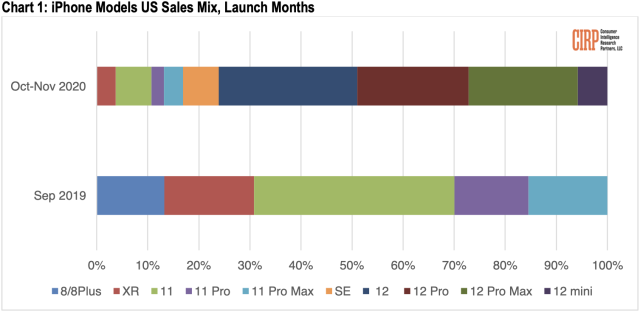-
A phone you can easily grasp with one hand? Crazy talk.Samuel Axon
-
The iPhone 12 mini.Samuel Axon
-
It's pretty thin.Samuel Axon
-
And yes, it still has a notch.Samuel Axon
-
The iPhone SE (left) and iPhone 12 mini (right) compared.Samuel Axon
Bad news for lovers of smaller phones: the iPhone 12 mini has sold poorly compared to other phones in the iPhone 12 lineup—poorly enough that analysts wonder whether Apple will remain committed to the smaller phone design moving forward.
A data firm called Counterpoint Research found that the iPhone 12 mini accounted for just 5 percent of overall sales from the company's smartphone lineup in early January. And J.P. Morgan analyst William Yang told Reuters that screens under 6 inches now account for only 10 percent of smartphones sold industry-wide.The data from Counterpoint is not the first to tell this story. Consumer Intelligence Research Partners (CIRP) broke down iPhone 12 lineup sales in detail last month. They found that the iPhone 12 Pro and 12 Pro Max made up about 20 percent of sales from the larger iPhone 12 lineup during the launch window, while the non-Pro, 6.1-inch iPhone 12 accounted for 27 percent.
But they also said the iPhone 12 mini "likely disappointed Apple" with only 6 percent of sales during the period measured—pretty close to the number Counterpoint shared a couple of months later.
Wave7 Research, another research firm, also estimated that the iPhone 12 mini accounted for 5 percent of iPhone 12 sales in the US. And Flurry Analytics declared the mini the least successful iPhone launch in the past three years.
While all this data shows that the iPhone 12 mini has underperformed, it doesn't tell us why. According to CIRP's data, the also-small iPhone SE performed a little better (likely due to its significantly lower price) but it still didn't make up a huge chunk of sales:

So while it's possible that the iPhone 12 mini's slow sales are partially a result of cannibalization by the cheaper SE, small phones are clearly not doing well in general.
When we reviewed the iPhone 12 lineup, we named the iPhone 12 mini as a favorite. There's a vocal crowd of smartphone users who see easy one-handed use as critically important, but these numbers indicate they are a minority.
There are a lot of reasons small phones are less popular now. For one thing, users are consuming more rich media content. Many people watch as much TV and film on their phones as they do on their TVs now, and some social media platforms like TikTok and Snapchat are focused on rich media that may be more enjoyable to some on a larger display.
People are doing more heavy-duty work on smartphones now, too, as evidenced by robust versions of applications like Word and a plethora of video and photo editing apps dominating the charts on the App Store. (It's a similar story over on the Android side.)
Despite those trends, the iPhone 12 mini seemed like it could be a moment of triumph for small-phone lovers—a chance for small phones to prove their market viability so this march to ever-larger screens could stop, at least for those who don't want those larger screens.
But if anything, these sales numbers make the future of one-handed smartphones look even dimmer than before.
Listing image by Samuel Axon
reader comments
316